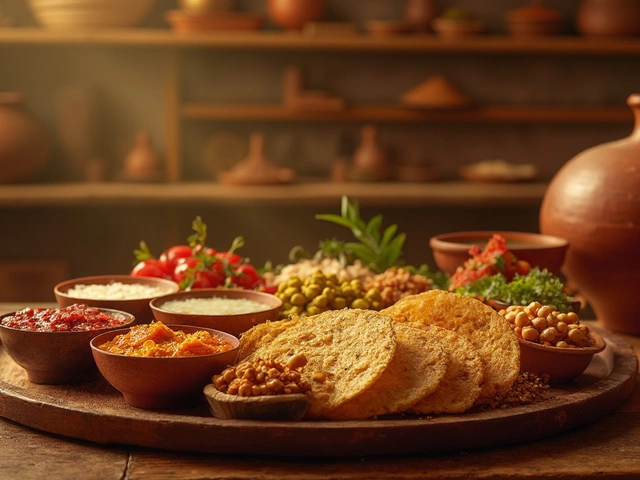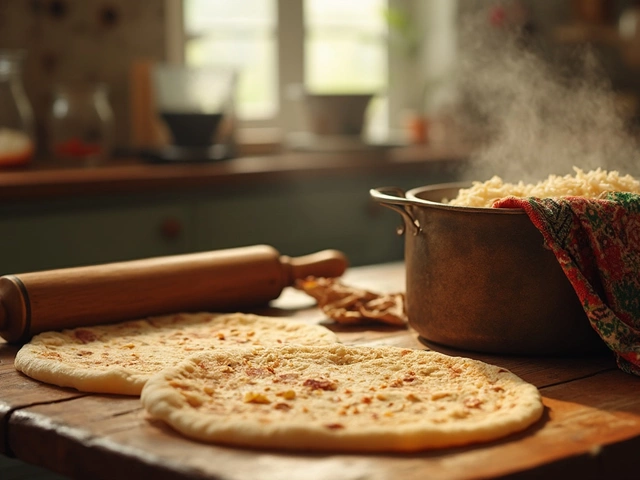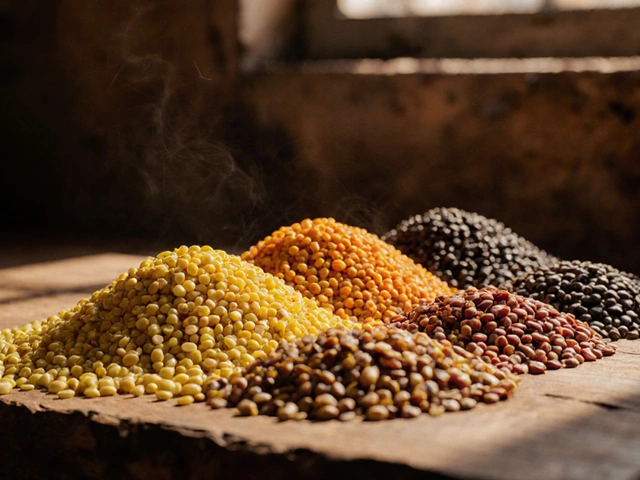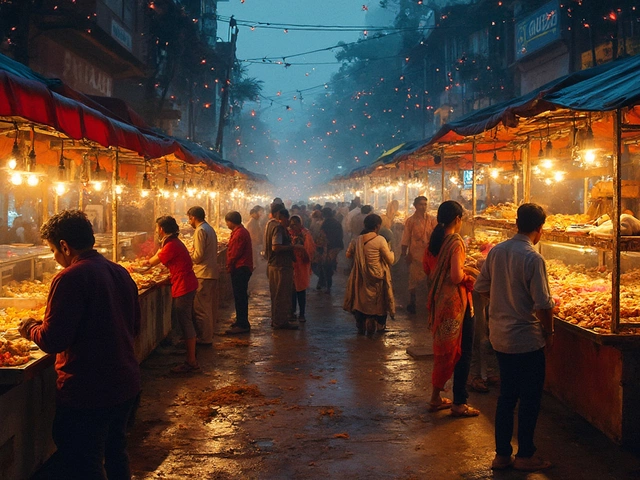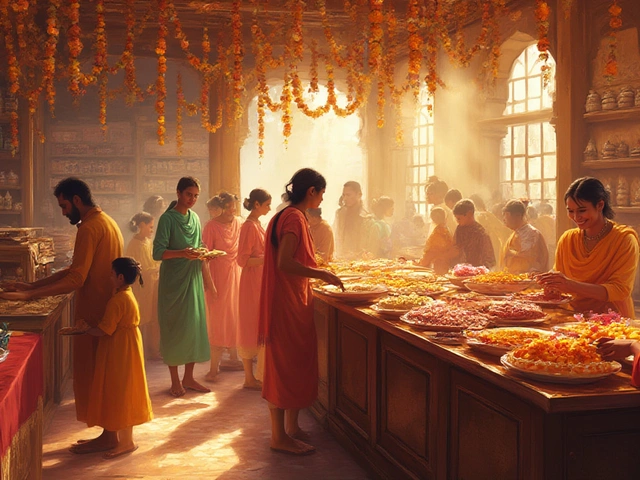No meat, no problem—Indian food makes going vegetarian both easy and seriously tasty. You’ll find Indian meals are packed with lentils, beans, veggies, and tons of flavor from spices. A typical spread isn’t built around steak or chicken like you see in some Western plates. Instead, it’s all about mixing foods so you get protein, fiber, and bold flavor in one meal.
If you’re picturing boring salads or bland steamed veggies, think again. Indian vegetarian meals use fillings like paneer (a type of cheese), hearty lentil stews, flatbreads like roti, plus all kinds of flavorful rice dishes. Even my kids beg for chana masala over pizza—who’d have guessed?
The meal setup usually goes like this: start with a dal (a lentil soup or stew), add a dry or saucy veggie side (think spiced potatoes or creamy spinach), then some rice or a flatbread to scoop everything up. Toss in a little yogurt or a spoonful of chutney and you’ve got a plate that leaves you full and happy—no meat required.
- What Goes into a Basic Vegetarian Indian Meal?
- Famous Vegetarian Indian Dishes You Should Try
- Tips for Building a Balanced Plate
- Everyday Shortcuts for Busy Cooks
What Goes into a Basic Vegetarian Indian Meal?
A classic vegetarian Indian meal is more than just veggies on a plate—it’s a full spread built to cover all your needs. The biggest players are lentils (dal), some kind of veggie side, and carbs like rice or flatbread. The goal? You get complete protein, filling fiber, and serious taste all in one go.
- Dal: This is the heart of most vegetarian Indian meals. Dal just means lentils, but it's cooked with lots of spices for a saucy, scoopable dish eaten with rice or roti. Popular types include toor dal (split pigeon peas), moong dal (mung beans), and masoor dal (red lentils).
- Sabzi: That’s the catch-all term for a vegetable side. Options range from aloo gobi (potato and cauliflower), bhindi masala (spiced okra), or baingan bharta (smoky, mashed eggplant). Each region has its favorites.
- Grains: Rice is a mainstay, but so are flatbreads like chapati, roti, or paratha. In South India, you’ll see dosa (a crispy crepe made from fermented rice and lentil batter) or idli (fluffy steamed rice cakes) served with sambar (a lentil stew).
- Extras: This is where things get fun—add a spoonful of tangy chutney, a dollop of cooling yogurt or raita, or a spicy pickle for contrast. These sides boost flavor and help balance spice.
For anyone wondering about nutrition, here’s a quick breakdown of a typical vegetarian Indian meal:
| Dish | Main Nutrients |
|---|---|
| Dal | Protein, fiber |
| Sabzi | Vitamins, fiber |
| Rice/Flatbread | Carbs, some protein |
| Yogurt/Raita | Calcium, probiotics |
What’s cool is how these pieces cover your protein and vitamin needs, even without meat or eggs. That’s one reason millions in India stick to vegetarian eating just fine. Plus, with all the spices (think turmeric, cumin, coriander), flavor never takes a back seat. For families, it means you can keep meals varied and satisfying every day—trust me, there’s zero chance of getting bored.
Famous Vegetarian Indian Dishes You Should Try
If you start asking around for the best vegetarian Indian meal, you'll keep hearing the same few names over and over. Seriously, these dishes show up at every big gathering and dinner table. They’re popular for a reason—they taste good, they fill you up, and most of them are easy enough to cook at home once you get the hang of the spices.
- Chana Masala: Chickpeas stewed in a tangy tomato gravy, usually finished with garam masala. It’s ridiculously protein-packed—if you need a filling lunch, this is it. Scoop it up with a roti or naan.
- Palak Paneer: Cubes of soft paneer cheese in a pureed spinach sauce. This dish has got iron, protein, and all the creamy comfort you’d expect from anything with cheese.
- Dal Tadka: Lentils simmered with onions, tomatoes, ginger, and then spiked with a smoky tempering of ghee and spices at the end. Most Indian homes have some kind of dal bubbling away at least three days a week. Add rice or flatbread and you’re set.
- Aloo Gobi: Potato and cauliflower cooked with cumin, turmeric, and coriander. Seriously kid-friendly—even picky eaters like mine will gobble this down with some plain yogurt on the side.
- Baingan Bharta: Roasted and mashed eggplant cooked with onions, tomatoes, and spices. Think of it like Indian baba ganoush, but spicier and perfect with naan.
- Vegetable Biryani: Spiced rice loaded with mixed veggies, sometimes nuts and dried fruit. This dish was actually ranked one of the most-ordered delivery items in several Indian cities in 2024 according to Swiggy’s year-end food report.
- Rajma: Kidney beans slow-cooked in a thick, spiced gravy. If you want old-school comfort food, serve this with steamed rice and you’ll understand why half of North India swears by it.
Need a quick look at what’s inside these classics? Check this table for the main protein source and a top nutrition perk for each dish:
| Dish | Main Protein | Nutrition Perk |
|---|---|---|
| Chana Masala | Chickpeas | High protein, fiber |
| Palak Paneer | Paneer & spinach | Protein, iron |
| Dal Tadka | Lentils | Iron, folate |
| Aloo Gobi | Cauliflower & potatoes | Vitamin C, potassium |
| Baingan Bharta | Eggplant | Antioxidants |
| Vegetable Biryani | Mixed veggies | Variety of vitamins |
| Rajma | Kidney beans | Protein, fiber |
Don’t feel you have to pick just one—mix and match a few of these to get the true Indian vegetarian dishes experience. You get flavor, variety, and a big nutrition boost all in one go.
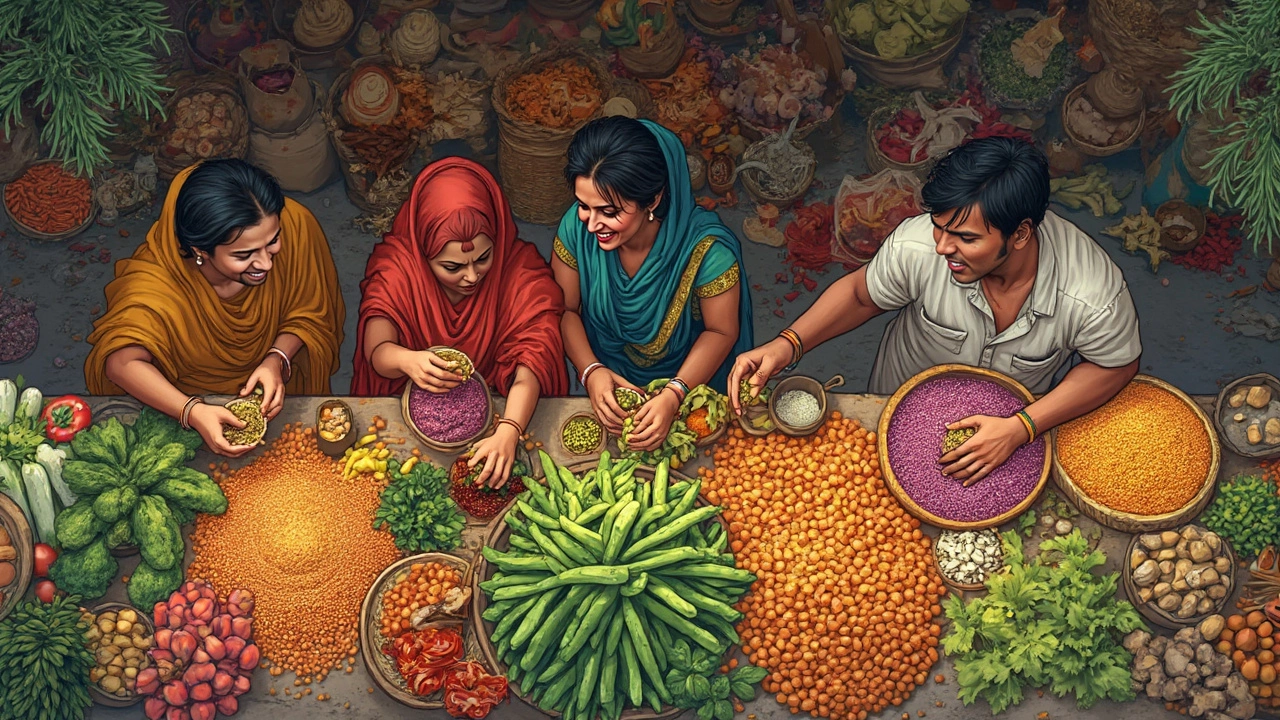
Tips for Building a Balanced Plate
Nailing a vegetarian Indian meal is all about hitting the right balance: protein, fiber, healthy fats, and flavor. Unlike some plant-based diets that leave you hungry an hour later, Indian meals keep you full because of their smart combos and variety. Here’s how you make sure your plate covers all the bases.
- Lentils and Beans Are Your Protein Powerhouses: Dal (lentil stew) or chana (chickpeas) give you filling protein and are the foundation of most Indian vegetarian dishes. A cup of cooked dal packs about 9 grams of protein, so don’t be shy with your servings.
- Vegetable Variety = More Nutrients: Always include at least one cooked veggie dish. Saag (spinach curry), baingan bharta (smoky mashed eggplant), or aloo gobi (potato-cauliflower dry curry) let you eat the rainbow without thinking too hard about it.
- Carbs Are Not the Enemy: Rice or roti (flatbread) gives quick energy and makes the meal filling. Opt for brown rice or whole wheat rotis if you want more fiber.
- Don’t Forget Healthy Fats: A drizzle of ghee or a scoop of coconut chutney adds healthy fat. These help your body absorb fat-soluble nutrients from veggies.
- Dairy for Creaminess and Extras: Paneer, yogurt, or lassi contribute protein, calcium, and a bit of creaminess. Even a simple bowl of raita (spiced yogurt) cools you off and supports gut health.
Dietitian Rujuta Diwekar, author of "Indian Superfoods," says:
“A proper Indian plate naturally balances protein, carbs, fat, and fiber—no crazy measurements or calorie counting needed, just real food in sensible portions.”
Trying to see what a balanced vegetarian Indian meal actually looks like? Here’s a simple breakdown many home cooks follow:
| Component | Suggested Portion | Common Examples |
|---|---|---|
| Protein (Dal/Beans) | 1 cup | Masoor dal, Rajma, Chana masala |
| Vegetables | 1/2–1 cup | Bhindi (okra), Baingan bharta, Aloo gobi |
| Carbs | 1 medium roti or 3/4 cup rice | Whole wheat roti, Brown rice |
| Dairy | 3–4 tbsp | Yogurt, Paneer |
| Fats | 1–2 tsp | Ghee, Coconut oil, Chutney |
If you’re in a rush, don’t stress. Even a bowl of dal over rice with a hunk of pickle and a few veggie slices can be a complete, flavorful vegetarian Indian meal you’ll actually look forward to.
Everyday Shortcuts for Busy Cooks
Let’s be real—some days, the last thing you want to do is chop and cook for hours. The good news? You don’t need a fancy kitchen or endless free time to pull together a solid vegetarian Indian meal that everyone will actually eat. Little hacks can make a big difference.
- Ready-Made Spice Blends: Don’t get lost in a maze of jars. Grab a pre-mixed masala—think garam masala or chana masala spice mixes. They pack all the classic flavors without the fuss. One teaspoon goes a long way and cuts your prep time in half.
- Canned Beans & Lentils: No time to soak and boil? Canned chickpeas, kidney beans, and even lentils work great. Just drain, rinse, and add them straight into your curry or stew. My kids have never noticed the difference (and frankly, neither have I).
- Frozen Vegetables: Bagged frozen peas, spinach, or mixed veggie blends are lifesavers. They’re just as healthy as fresh produce—sometimes even ‘fresher’ since they’re frozen at peak ripeness—and they’re ready in minutes.
- Rice Cooker or Instant Pot: Don’t waste time watching a pot boil. Dump your rice (or dal) in a rice cooker or Instant Pot, set the timer, and forget about it. You can even cook most dals with spices and tomatoes in one go.
If you’re still not convinced, hear it from Madhur Jaffrey, the queen of Indian home-cooking:
“Frozen or canned ingredients are not just convenient—they make healthy, everyday Indian cooking possible even on the busiest nights.”It’s not about cutting corners, it’s about working smarter.
| Shortcut | Average Time Saved |
|---|---|
| Canned Beans vs. Dry Beans | 45 min |
| Rice Cooker vs Stovetop | 20 min |
| Frozen vs Fresh Veggies | 15 min |
For flavor boosts, keep a stash of store-bought chutneys and yogurt. Toss these on the table, and your simple vegetarian Indian dishes instantly feel more special. Don’t stress about getting every detail perfect—just keep things tasty, colorful, and quick. Your future self (and your hungry crew) will thank you.







